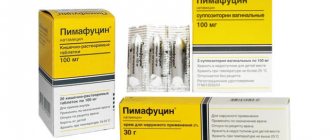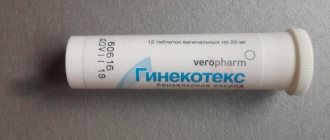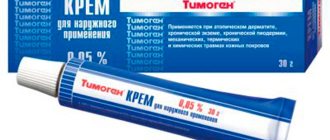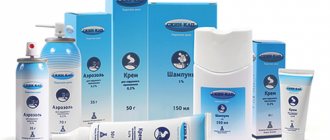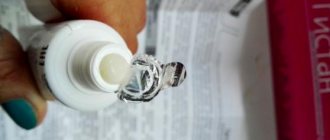Contraindications for use
Clindacin cream and ointment are not prescribed to patients:
- with hypersensitivity to the active or auxiliary components of the drug;
- with inflammatory bowel diseases (including colitis and Crohn's disease);
- under 18 years of age.
The drug should be used with extreme caution when taking muscle relaxants and having allergic diseases.
Drug interactions
Cross-resistance may develop with concomitant use of clindamycin and lincomycin. According to studies, the combined use of clindamycin and erythromycin leads to a mutual decrease in the therapeutic effect.
Neuromuscular transmission may be slightly impaired by systemic use of the drug. Therefore, it is recommended to avoid prescribing the cream together with muscle relaxants. If it is necessary to use these medications, both drugs are prescribed extremely carefully and are used only under the supervision of the attending physician. The simultaneous use of the product with similar drugs should be avoided.
It is prohibited to use the cream together with the following medications:
- magnesium sulfate;
- calcium gluconate;
- aminoglycosides;
- ampicillin.
It is also prohibited to use the product simultaneously with solutions that contain a complex of B vitamins.
Pregnancy and lactation
The use of Clindacin cream during pregnancy is permitted only for absolute indications, that is, when it is impossible to do without its use.
Studies regarding the effect of the drug on the course of pregnancy and fetal development when using clindamycin in the first trimester have not been conducted. Several animal experiments have been carried out. The results showed that subcutaneous and internal administration of the substance had no effect on the fetus. The only exceptions were cases of taking doses toxic to the mother.
Experiments conducted in the second and third trimesters showed that the use of clindamycin does not increase the likelihood of fetal abnormalities. However, the drug is prescribed only in cases of extreme necessity.
As for the period of breastfeeding, clandamycin passes into milk if drugs with it were used parenterally or orally. There is no information about intravaginal use. However, in any case, the woman is asked to either stop using the drug or stop breastfeeding for the duration of treatment.
Side effects
In most cases, Clindacin vaginal cream is well tolerated by patients. But sometimes it causes some side effects. In the instructions for the Clindacin Prolong cream, the manufacturer warns about possible adverse reactions:
- burning, swelling of the vaginal mucosa, irritation at the injection site;
- cramps or pain in the lower abdomen;
- allergic reactions;
- hyperthyroidism;
- development of hypersensitivity;
- dizziness, headaches;
- vertigo;
- development of fungal infections (candidiasis);
- upper respiratory tract infections;
- nausea, vomiting, constipation, diarrhea, flatulence, bad breath, intestinal disorders;
- itching, rash, urticaria, erythema;
- abnormal birth;
- menstrual irregularities;
- vaginal discharge;
- local inflammatory reactions.
If side effects occur, you should stop using Clindacin cream and consult a doctor.
Directions for use and doses
Clindacin cream is intended for intravaginal use. The procedure is carried out using disposable applicators, which can be found in the packaging with the medicine.
The applicator is very easy to use. It is enough to screw it to the neck of the tube with cream. After this, start pressing on the tube to dispense the cream. There is no need to touch the applicator piston; it will rise on its own. As soon as the piston reaches the stop, this will mean that the dose of the drug is ready and you can begin to administer it.
The manipulation must be performed while lying on your back with your knees pulled up to your chest. The applicator must be inserted as deep into the vagina as possible without causing discomfort or pain. It must be in a horizontal position. After the cream is injected, the applicator must be carefully removed and discarded.
According to the instructions, Clindacin cream must be applied once a day. It is recommended to do this before bed. In most cases, a single dose is 5 g of the drug (one full applicator). The course of treatment lasts from three to seven days.
In what form is it produced?
Clindacin B prolong (3 applicators for administering the cream are included in the package) is produced in Russia in the form of a vaginal cream for local administration. The kit includes special attachments (applicators) that allow you to introduce the cream into the vaginal cavity. Liniment is white or almost white with a grayish tint. It has a specific smell.
Prices for medications may vary depending on the pharmacy chain, as well as the region and area of sale:
| Region | Form/dosage | Price |
| Moscow, Moscow region | Cream 2%, 6 g | 615-740 rub. |
| Saint Petersburg | Cream 2%, 20 g | 165-1015 rub. |
| Leningrad region | Cream 2%, 40 g | 490-800 rub. |
| Novgorod region | Cream 2%, 6 g | 625-735 rub. |
Overdose
No cases of clindamycin overdose with intravaginal use have been identified. This is only possible in cases where the amount of active substance sufficient to cause systemic reactions has been absorbed into the body.
Systemic effects can also be caused by accidental ingestion of Clindacin cream into the gastrointestinal tract. They may be similar to those that appear after oral administration of a therapeutic dose of the active substance. In addition, side effects such as diarrhea or pseudomembranous colitis may occur.
There is no special antidote to get rid of unexpected reactions. If they occur, symptomatic treatment is necessary.
special instructions
Before prescribing Clindacin cream, laboratory tests must be used to exclude diseases such as trichomoniasis, chlamydia, gonorrhea and herpes simplex. Their pathogens often cause the development of vulvovaginitis.
Parenteral or internal use of clindamycin, which is an antibiotic, can cause diarrhea. If this symptom has a pronounced form, treatment with the drug should be stopped.
Patients should not have sexual intercourse during the entire period of treatment.
The use of Clindacin cream cannot be combined with the use of other intravaginal agents.
The components that make up the medication can reduce the strength of rubber and latex products (condoms, vaginal contraceptive diaphragms, and so on). Therefore, they cannot be used during treatment and for another three days after its completion.
If after treatment the symptoms of the disease persist, it is necessary to undergo a re-examination to identify the pathogen, make a diagnosis and choose another method of therapy.
Clindacin cream does not affect reactions, so the patient can continue to drive a car and operate other mechanisms.
"Dalacin"
The drug is available in the form of a cream and is used to treat bacterial vaginosis. The drug is not prescribed if there is hypersensitivity to the active or auxiliary components that are part of the medication.
As for application, as in the case of Clindacin, Dalacin is administered using an applicator. The duration of treatment should be at least three, but not more than seven days.
In 90% of cases, the use of this medication occurs without complications. In the remaining 10% of patients it is possible:
- irritation of the vaginal mucosa, its redness and itching;
- vaginal discharge;
- headache or dizziness;
- abdominal pain, cramps;
- digestive disorders;
- fungal infections;
- bacterial infections;
- fever.
The drug is available without a prescription.
Compound
The product contains 2 active ingredients - butoconazole nitrate and clindamycin phosphate. Both substances have pronounced antifungal and antimicrobial effects.
Additional composition:
- preservative agent Euxil PE9010;
- propylene glycol;
- macrogol-20;
- cetostearyl ether compound;
- cetostearyl alcohol;
- isopropyl myristate;
- sodium hydroxide;
- additive E-1442;
- filtered water.
Auxiliary components allow you to enhance the effect of the main ingredients, increasing their therapeutic effect.
"Clindamycin"
This vaginal cream is prescribed for the treatment of vaginitis caused by microorganisms sensitive to the active substance of the drug.
Clindamycin is not prescribed to patients with hypersensitivity to its components, as well as in the first trimester of pregnancy. The product should be used with caution during lactation.
The cream is administered intravaginally, 1 applicator at a time, for three to seven days.
Side effects are rare and can manifest themselves in the form of allergic reactions, irritation at the site of application, fungal vaginitis, cervicitis.
An overdose can lead to increased severity of side effects. In this case, the use of Clindamycin must be stopped.
The medication is available by prescription.
Pharmacodynamics
The first main substance (butoconazole) exhibits fungicidal properties against the following pathogenic microorganisms:
- candida mushrooms;
- epidermophyton;
- microsporum;
- trichophyton.
At the same time, the component also has an effect on some types of gram-positive microflora. It is most effective against bacteria that cause candidiasis. Its action is aimed at suppressing the production of ergosterol in fungal cells, which leads to an increase in membrane permeability and, as a result, causes the death of the microorganism.
The second active ingredient (clindamycin) belongs to the lincosamide class and is a representative of antibiotics that exhibit a bacteriostatic effect. It has a wide spectrum of activity, suppressing protein production in the microorganism cell. The component has a bactericidal effect against some gram-positive bacteria.
The following pathogens are sensitive to the active substance:
- Gardnerella vaginalis;
- mobiluncus;
- peptostrepococci;
- bacteroides;
- mycoplasma (hominis).
Thanks to its properties, the cream is converted into a gel base and is retained on the surface of the vagina for 1-3 days.
"Klindovit"
The drug is available in gel form and is intended for external use. It is used to treat acne.
The drug is not prescribed if the patient has:
- hypersensitivity to active substances;
- ulcerative colitis;
- Crohn's disease;
- pseudomembranous colitis.
Clindovit is prescribed with extreme caution:
- nursing mothers;
- children under 12 years of age;
- nursing women;
- patients who are predisposed to developing allergic reactions.
The gel is well tolerated by patients. Only in rare cases, side effects may occur at the site of application: irritation, itching, burning, dryness and flaking of the skin, increased secretion of sebum, contact dermatitis.
It is very important to avoid contact of the gel with the mouth and eyes. After use, be sure to wash your hands.
pharmachologic effect
Clindamycin has a bacteriostatic (does not destroy, but inhibits development) effect, although in high concentrations a bactericidal effect is also possible. Penetrating into the bacterial cell, the antibiotic inhibits protein synthesis, which prevents the microorganism from properly growing and developing. The spectrum of action of the drug extends over a wide range. Clindacin is active against certain types of staphylococci and streptococci. It is effective against bacterial vaginosis caused by gardnerella, mobiluncus, bacteroides, mycoplasma, and some types of clostridia. According to reviews of Clindacin from medical practitioners, the drug does not act on trichomonas and candida, and has cross-resistance with lincomycin.
"Zerkalin"
The drug based on clindamycin is available in the form of a colorless transparent liquid with a characteristic odor.
The solution is intended for external use and is used to treat acne.
The drug is not prescribed:
- children under 12 years of age;
- with antibiotic-associated colitis;
- if there is hypersensitivity to clincomycin or clindamycin.
The drug should be used with caution if there is a predisposition to allergic reactions.
As for side effects, quite often the use of “Zerkalin” causes dryness and irritation of the skin. Much less common are contact dermatitis, digestive disorders, and eye pain.
"Zerkalin" is applied topically twice a day. It should be applied to previously cleansed affected areas of the skin.
The drug is available from the pharmacy without a prescription.
Patient reviews
If you read reviews about Clindacin cream, it will become clear that this is a truly effective remedy. Most patients felt positive changes (and smear analysis confirmed them) after just three days of treatment. In addition, they note the following as the advantages of the drug:
- ease of use;
- no need to store the cream in the refrigerator and then reheat before use;
- absence of too pronounced odor;
- the presence of special applicators in individual packages.
But there are also those who are completely dissatisfied with the drug. There are not so many of them, but to complete the picture, it is worth mentioning the shortcomings that patients mentioned in their reviews:
- lack of any effect;
- development of thrush after using the cream;
- the appearance of vaginal discharge;
- the cream package is designed for 3 days, so for a longer course of treatment you will have to take 2 or 3 at once;
- The cost of the drug is quite high (varies within 500 rubles depending on the region and pharmacy).
Be that as it may, there are many times more positive reviews than negative ones.
Release form
Clindacin is available in two dosage forms: vaginal cream and vaginal suppositories (aka suppositories).
The cream is a white substance with a slight yellowish tint of appropriate consistency, placed in aluminum tubes of 20 or 40 g. In addition to the tube with the medicine itself, special applicators are also included in the secondary packaging (3 or 7, respectively, depending on the amount of cream in the tube) for installation cream in the vagina. The concentration of the active substance (clindamycin plays its role) is 2%, i.e. 2 mg per 1 g. This dosage form is produced by the oldest Russian pharmaceutical company Akrikhin.
Vaginal suppositories have a color similar to the cream, and are packaged at the rate of 3 suppositories in one individual package. The content of clindamycin is 100 mg per suppository. The manufacturer of Clindacin in the form of vaginal suppositories is Pharmaprim LLC (Moldova), and the suppositories are packaged with the same domestic Akrikhin.


